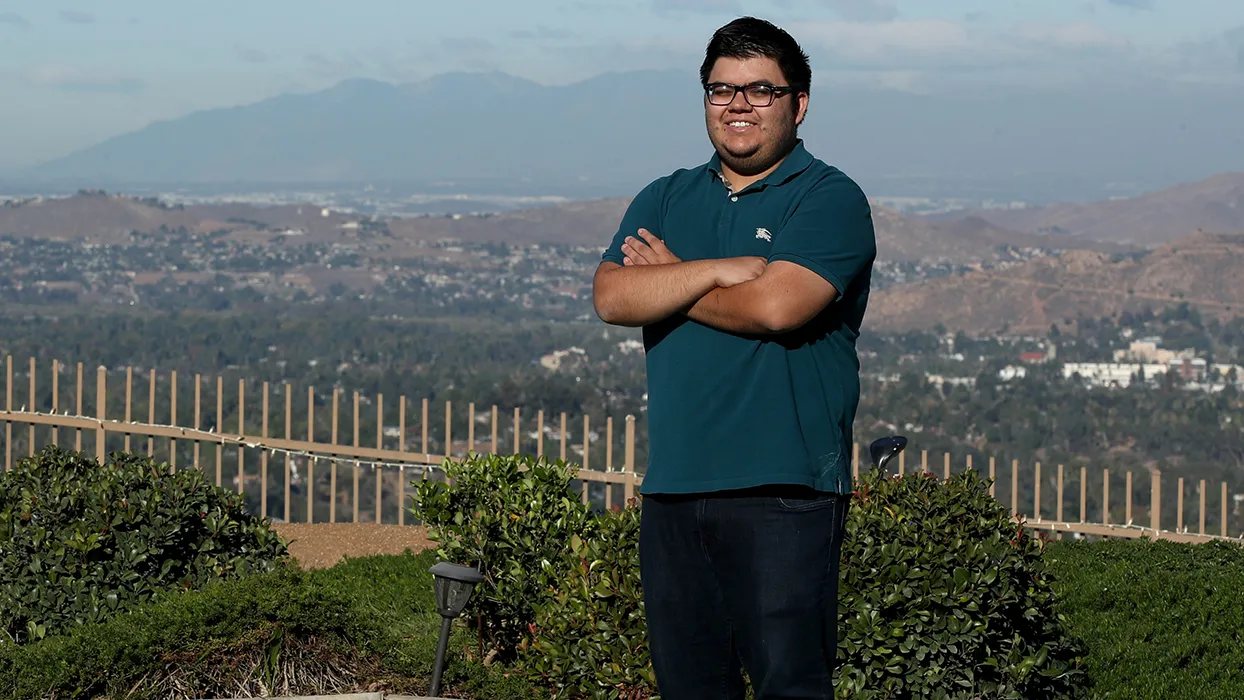Joe Gutierrez | Office of Strategic Communication | (909) 537-3007 | joeg@csusb.edu


Mark Araujo-Levinson, a CSUSB senior, is seated in a classroom at the Morongo School in Banning. Gathered around him on the floor are 12 pre-school children, some fidgeting, some waiting expectantly.
“Hakup ye'aye'a'n taamit ya'ki' nepuuyum?” says Araujo-Levinson in Serrano. “Beautiful day isn’t it, my friends?”
“Werre’! Haminat!” the students reply in unison. “Yes! Hello!”
Twice a week, Araujo-Levinson sets out from Riverside to make the 60-mile roundtrip drive to the Morongo Indian Reservation, home to the Morongo Band of Mission Indians, to teach Serrano language classes to approximately 100 pre-school through eighth-grade students. Serrano, a subset of the Uto-Aztecan language, is an Indigenous California language thought to be more than 2,500 years old.
“It is said that the Serrano language is ancient, that the Creator gave the people their language,” said Araujo-Levinson. Sadly, it is a language that faces extinction.
But Araujo-Levinson is determined to change that. A language preservation specialist with the Morongo Cultural Heritage Department, he has learned at least 15 Indigenous California languages, all of which face extinction.
“I think it is important to preserve these languages because the history, perspective of the people, culture, and anything similar is engraved into the language,” he said. “Once it is gone, you lose so much.”
His goal: to help his students understand how important learning a native language is to their identities, and to ignite in them “a fire and a spark to want to be the best speaker,” he said.
For more than half his life, the 26-year-old math major has himself been infused with a spark and fascination for other languages. As a high school student, he challenged himself to learn 10 languages, which had the unintended and therapeutic consequences of lifting him out of depression, a condition he still experiences. Today, he said, “Languages and mathematics are my therapy.” A personal essay recounting his multilingualism was included in a 2016 book titled “The Bible of Language Learners and Polyglots” by Jimmy Mello.
In 2017, his curiosity about California’s Indigenous languages led him to Ernest Siva, an elder, tribal historian and cultural advisor with the Morongo Band of Mission Indians. Siva’s aunt, Dorothy Ramon, who died in 2002 at age 93, was the last “pure” speaker of Serrano, meaning it was her first language as she grew up. Siva and his wife founded the Dorothy Ramon Learning Center in Banning to inspire and advance discovery, understanding and continuance of tribal cultures.
In November of 2017, Siva and Araujo-Levinson began to meet weekly, and over the course of the next 13 months, the elder became Araujo-Levinson’s mentor, teaching him the Serrano language during their one-on-one sessions. The lessons included much more than language instruction.
“During the first meeting, I realized Mr. Siva knew more of the language than I anticipated,” Araujo-Levinson recalled. “Whether it was the language or songs or history, I learned something new at every meeting.”
During those meetings, Siva also passed along a philosophy that Araujo-Levinson has adopted, and “holds near and dear.” That is, “You teach [the language] to whoever wants to know. Of course, there are boundaries.” For example, he explained, he would never ask Siva about topics that are sacred to the culture. “But if somebody wants to learn how to say hi, how to say the color blue, you tell them. I think Mr. Siva follows the example of his aunt and his elders, who shared what they knew and what they learned to keep the language alive.”
Araujo-Levinson learned the language quickly, and at Siva’s recommendation, he was hired as a language preservation specialist in March 2019 and began teaching Serrano at the Morongo School, where it is a required class for all students.
Stories about Siva and Araujo-Levinson’s unique relationship and their efforts to revitalize California’s Indigenous languages have been featured in the L.A. Times, on KCRW radio and on the Dorothy Ramon Learning Center website. And in an op-ed for the L.A. Times, Araujo-Levinson makes a compelling case for the importance of keeping California’s Indigenous languages alive.
Looking toward the future, Araujo-Levinson plans to graduate in December and pursue a Ph.D. in math in the field of mirror symmetry.
Where does language fit in? “It’s always going to be a hobby of mine, regardless,” he said. “As I mentioned earlier about the philosophy I learned from Mr. Siva, I’m always willing to help teach whoever wants to know.”
And, after researching his own family history and discovering the story of his great-grandfather, Carmen Cisneros, a descendant of the Mixtec, a Mexican Indigenous group, he plans to study, and eventually speak, the language of his own ancestors.
ADDITIONAL RESOURCES
CSUSB offers a variety of California’s Indigenous language classes, including a certificate program in California Indian Languages and Cultures, as well as for-credit courses in Cahuilla, Serrano and Luiseño. CSUSB’s Center for Indigenous Peoples Studies offers innovative and productive programs for the study of American Indians and partnerships with local, national and international Indigenous Peoples.